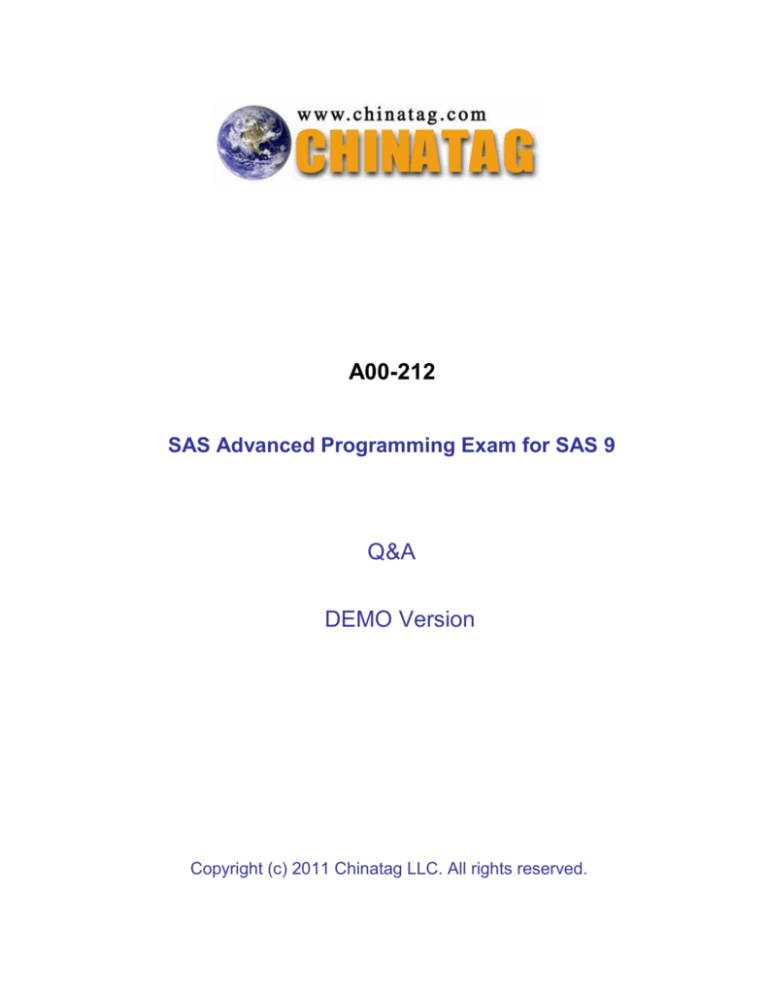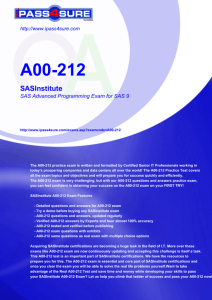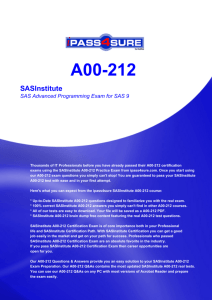
A00-212
SAS Advanced Programming Exam for SAS 9
Q&A
DEMO Version
Copyright (c) 2011 Chinatag LLC. All rights reserved.
Important Note
Please Read Carefully
For demonstration purpose only, this free version Chinatag study guide contains 10 full length questions selected
from our full version products which have more than 200 questions each.
This Study guide has been carefully written and compiled by Chinatag certification experts. It is designed to help you
learn the concepts behind the questions rather than be a strict memorization tool. Repeated readings will increase
your comprehension.
For promotion purposes, all PDF files are not encrypted. Feel free to distribute copies among your friends and let
them know Chinatag website.
Study Tips
This product will provide you questions and answers along with detailed explanations carefully compiled and written
by our experts. Try to understand the concepts behind the questions instead of cramming the questions. Go through
the entire document at least twice so that you make sure that you are not missing anything.
Latest Version
We are constantly reviewing our products. New material is added and old material is revised. Free updates are
available for 90 days after the purchase. You should check the products page on the http://www.chinatag.com
website for an update 3-4 days before the scheduled exam date.
Please tell us what you think of our products. We appreciate both positive and critical comments as your feedback
helps us improve future versions. Feedback on specific questions should be send to feedback@chinatag.com.
Thanks for purchasing our products and look forward to supplying you with all your Certification training needs.
Good studying!
Technical and Support Team
Chinatag LLC.
Leading the way in IT testing and certification tools, www.chinatag.com
-2-
A00-212
QUESTION NO: 1
The following SAS program is submitted:
Data sasuser.history;
Set sasuser.history(keep=state x y
Rename = (state=ST));
Total=sum(x,y);
Run;
The SAS data set SASUSER.HISTORY has an index on the variable STATE.
Which describes the result of submitting the SAS program?
A. The index on STATE is deleted and an index on ST is created
B. The index on STATE is recreated as an index on ST
C. The index on STATE is deleted
D. The index on STATE is updated as an index on ST
Answer: C
QUESTION NO: 2
The following SAS program is submitted:
%macro one(input);
%two;
%put the value is &date;
%mend;
%macro two;
data _null_;
call symput('date','12SEP2008');
run;
%mend;
%let date=31DEC2006;
%one(&date)
What is the result when the %PUT statement executes?
A. A macro variable DATE with the value 12SEP2008 is retrieved from the local symbol
table for the ONE macro
B. A macro variable DATE with the value 12SEP2008 is retrieved from the local symbol
table for the TWO macro
C. A macro variable DATE with the value 12SEP2008 is retrieved from the global
symbol table
D. A macro variable DATE with the value 31DEC2006 is retrieved from the global
symbol table
3
A00-212
Answer: C
QUESTION NO: 3
Which SET statements option names a variable that contains the number of the
observation to read during the current iteration of the DATA step?
A. OBS=pointobs
B. POINT=pointobs
C. KEY=pointobs
D. NOBS=pointobs
Answer: B
QUESTION NO: 4
When reading a SAS data file, what does the NOBS=option on the SET statement
represent?
A. A variable that represents the total number of observation in the output data set(s)
B. A variable that represents a flag indicating the end of the file
C. A variable that represents the total number of observations in the input data set(s)
D. A variable that represents the current observation number
Answer: C
QUESTION NO: 5 CORRECT TEXT
CORRECT TEXT
The following SAS program is submitted:
%macro check(num=4);
%let result=%sysevalf(&num+0.5);
%put result is &result;
%mend;
%check(num=10)
What is the written to the SAS log?
result is
result is 10
result is 10.5
result is 10+0.5
4
A00-212
Answer: C
QUESTION NO: 6
The following SAS program is submitted:
%micro test(var);
%let jobs=BLACKSMITH WORDSMITH SWORDSMITH;
%let type=%index(&jobs,&var);
%put type = &type;
%mend;
%test(SMITH)
What is the value of the macro variable TYPE when the %PUT statement executes?
A. 0
B. Null
C. 6
D. 3
Answer: C
QUESTION NO: 7
The following SAS program is submitted:
%macro check(num=4);
%let result=%eval(&nm gt 5);
%put result is &result;
%mend;
%check (num=10)
What is written to the SAS log?
A. result is true
B. result is 10 gt 5
C. result is 1
D. result is 0
Answer: C
QUESTION NO: 8
The following SAS program is submitted:
data temp;
5
A00-212
length 1 b 3 x;
infile 'file reference';
input a b x;
run;
What is the result?
A. The data set TEMP is not created because variables A and B have invalid lengths
B. The data set TEMP is created, but variable X is not created
C. The data set TEMP is not created because variable A has an invalid length
D. The data set TEMP is created and variable X has a length of 8
Answer: C
QUESTION NO: 9
Given the SAS data sets ONE and TWO:
The following SAS program is submitted:
Proc sql;
Select two.*,budget from one <insert JOIN operator here> two on one.year=two.year,
Quit;
The following output is desired:
Which JOIN operator completes the program and generates the desired output?
A. FULL JOIN
B. INNER JOIN
C. LEFT JOIN
D. RIGHT JOIN
Answer: A
6
A00-212
QUESTION NO: 10
Given the SAS data set SAUSER.HIGWAY:
SASUSER.HIGHWAY
The following SAS program is submitted:
%macro highway;
proc sql nonprint;
%let numgrp=6;
select distinct status into:group1-:group&numgrp from sasuser.highway;
quit;
%do i=1 %to &numgrp;
proc print data =sasuser.highway;
where status ="&&group&I";
run;
%end;
%mend;
%highway
How many reports are produced?
A. 2
B. 6
C. 0
D. 5
Answer: A
7












